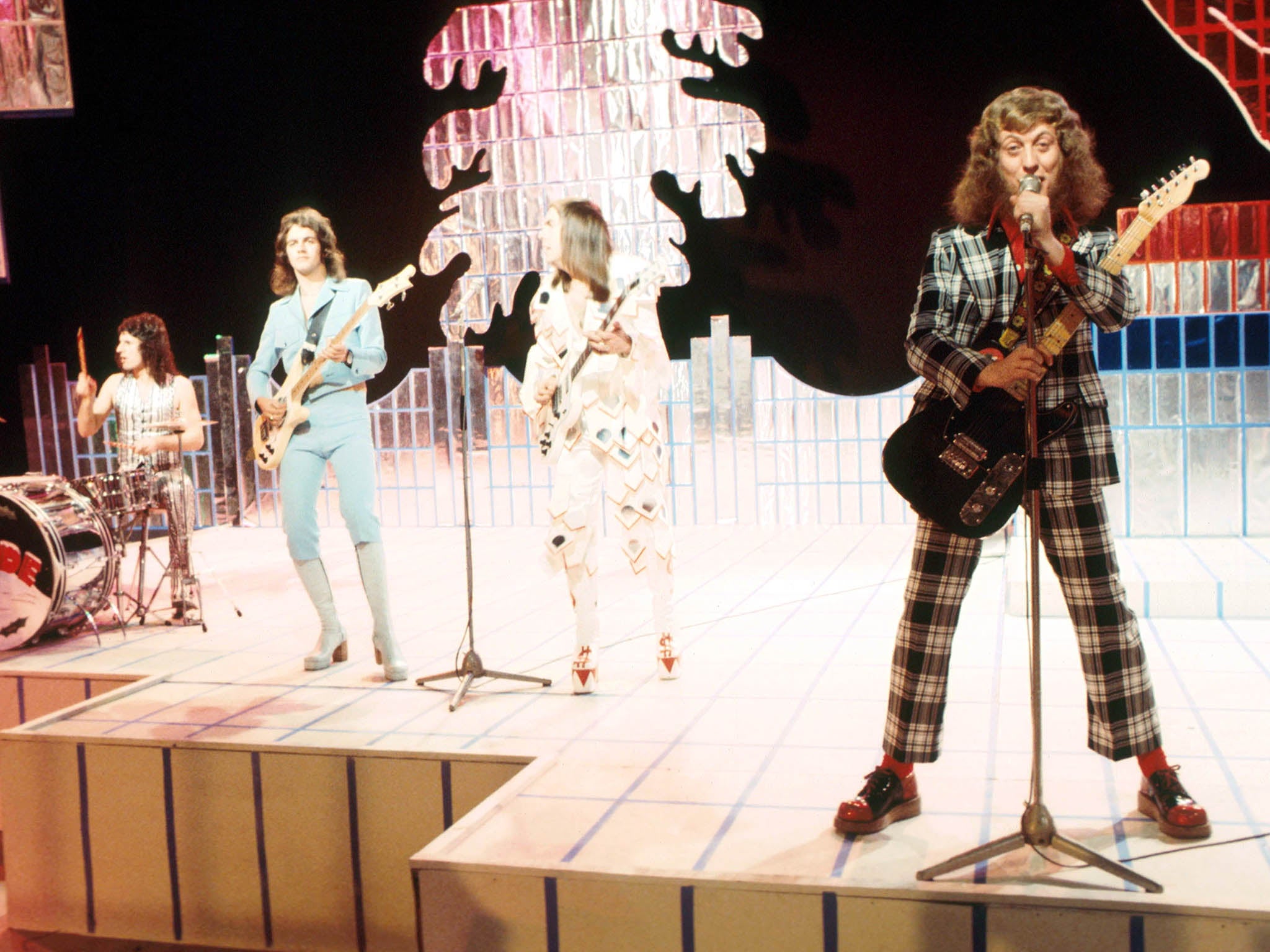The surprising glam rock roots of your favourite Christmas No 1
From Whamageddon to LadBaby, Marc Burrows tells the story of how a competition between two over-the-top Seventies icons established a December tradition that we still celebrate today


It’s been 50 years exactly since the first Christmas No 1; when glitter-encrusted Black Country rockers Slade got to the top with their stompy, rousing and very British hit “Merry Xmas Everybody”, beating glitter-encrusted Brummie rockers Wizzard, whose stompy, rousing and very British hit, “I Wish It Could Be Christmas Everyday” stalled at No 4. British readers will have heard both songs, repeatedly, every year of their lives, ever since.
OK, technically the “first ever UK Christmas No 1” was by American crooner Al Martino, in 1952. But I’m not counting that. Firstly, because there wasn’t a reliable national chart until the late Sixties, but more than that, Al Martino doesn’t get to be counted as a Christmas No 1 because the Christmas No 1 didn’t really exist until 1973. Up to that point, there was just… a No 1 that happened to be at Christmas.
That was desirable, sure: singles made great Christmas presents, so a hit in December came with huge sales. But in terms of a cultural moment? The concept just didn’t exist. Bookies weren’t taking bets on who would top the charts at Christmas. TV news programmes weren’t running bulletins updating viewers on the race. According to the OED, the term “Christmas No 1” didn’t even appear in print before 1973, though it’s been a ubiquitous part of the media landscape every December since then.
So why was 1973 different? Firstly, two of the biggest bands in the country both, independently of one another, decided to record Christmas songs. It was unprecedented. Slade and Wizzard were cool bands, adored by both teenyboppers and credible rock fans alike, and mainstays of the NME, Melody Maker and Record Mirror.
And they were huge. Roy Wood of Wizzard had previously been in The Move (the first band ever played on Radio 1) and ELO, and Wizzard’s “See My Baby Jive” had held the top spot for nearly a month that spring.
Slade’s “Cum on Feel The Noize” was one the biggest smashes of the year. They were getting mobbed by schoolgirls on the street. Back then, acts like those simply didn’t release Christmas songs. It wasn’t done.
For both bands that was sort of the point. “I decided to make a Christmas single because they’d been unfashionable for years,” Wood told The Guardian back in 2011. “We thought it would be worth trying a real rock’n’roll Christmas song.” For Slade’s Noddy Holder it was about making a relatable Christmas song for British fans. “I wanted it to paint a picture of a typical working-class Christmas,” he told the official PRS website that same year. “You know, granny getting up and having a dance and worrying about how much room there is with all the relatives.”
And 1973 itself was a miserable year, blighted by IRA bombings, industrial action, a huge spike in inflation and an oil shortage that led to power cuts and, eventually, a temporary three-day working week to conserve energy supplies. It was an environment where the escapist fantasy of glam rock, in glittering platform boots and sparkling make-up, was pretty appealing. Add Christmas to that – bigger, shinier, more excessive still – and you can see why the public took the records to their heart.
They were both big-sounding, brilliant songs, too (though a half-century of constant overplaying has slightly dulled their edge). Both had humdinger choruses, great lyrics and a dollop of knowing wit that felt very British; from the ring of cash registers that kicks off “I Wish …” to Noddy Holder’s granny “up and rock and rolling with the rest”. The schmaltzy Americana of Andy Williams, Dean Martin and Bing Crosby never sounded this fun.
It was Slade who eventually won the race, going straight in at No 1 on 9 December with a staggering 500,000 copies shifted in its first week, holding the spot comfortably into Christmas week and staying put right into January.
Wizzard had a slower start, debuting just inside the top 20 on 2 December, but clawing their way up to No 4 by the 16th where they stayed into the new year.
The two records sold in staggering quantities, and suddenly the idea of a Christmas single being popular, cool and causing an exciting media storm in a traditionally slow news week was born. The following year fellow glitter rockers Mud scored the top spot with “Lonely This Christmas”, in a chart that also included glam-tastic Christmas songs by Showaddywaddy and The Wombles.
By 1975, the super-serious musos were getting in on the act – Greg Lake’s “I Believe In Father Christmas” might have only made No 2, but it sold by the bucket-load, and it was only Queen’s “Bohemian Rhapsody” that kept it in check.
Slade and Wizzard had made the Christmas No 1 the jewel in the pop crown. The ultimate accolade. If you were accepted at Christmas, you were accepted by everyone. It’s why Wham! knew that “Last Christmas” was their most important record, and why Shakin’ Stevens held “Merry Christmas Everyone” back a whole year so he wouldn’t have to compete with it (or, indeed, Band Aid).
It’s why reality TV singing competitions see the Christmas No 1 as their ultimate prize. Why Cliff Richard’s shelf life was extended well into the Nineties. They kept selling, too. At last count, Slade’s “Merry Xmas Everybody” had sold 1,200,000 copies in the UK alone, while “I Wish It Could Be Christmas Everyday”, once the runner-up, is at 1,800,000.
You can see the appeal, and it’s not just about a sleigh-load of cash every year. If you can have your music associated with magic, positivity and joy, then that’s a kind of immortality. People go back to those Slade and Wizzard records every year. They go back to “Last Christmas” and “Stop The Cavalry” and “Do They Know It’s Christmas?” and “Stay Another Day”.
Those songs become part of our lives. That’s remarkable. That all came from the glam era, when two over-the-top, very British rock bands realised they could wear twice as much glitter than usual, put a big smile on the face of the public and sell by the bucket-load. Every. Single. Year.






Join our commenting forum
Join thought-provoking conversations, follow other Independent readers and see their replies
0Comments